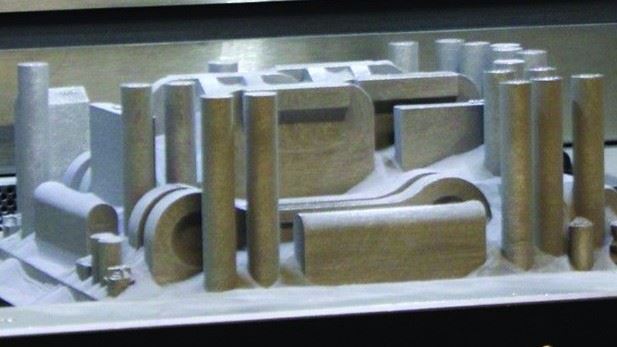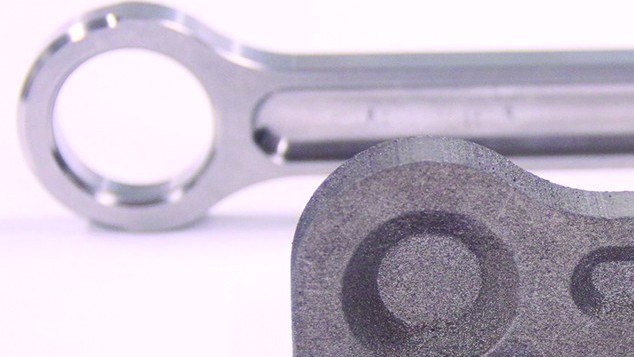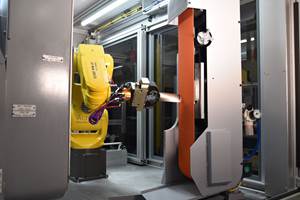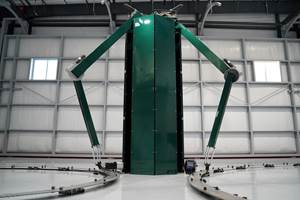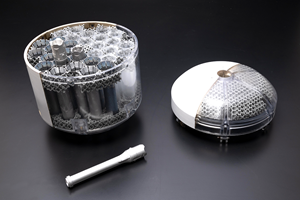Are AM Parts as Strong as Those Made Conventionally?
An additively manufactured flight-critical helicopter part indicates that they are.
The last few months, I have been focusing on several of the safety concerns related to using metallic powder feedstocks in additive manufacturing (AM), including inhalation risks, safe powder handling and pyrophoric hazards. While these concerns may have scared off some of you, it is important that everyone understand all aspects of AM as it gains industry acceptance. Too many stories just focus on the power and potential of AM, creating unrealistic expectations and fairytale scenarios.
This month, however, I want to return to discussing the benefits of AM and share a case study we have been involved with in the Center for Innovative Materials Processing through Direct Digital Deposition (CIMP-3D) at Penn State. As the co-director of CIMP-3D, I help give tours to the more than 1,000 people that visit each year to see firsthand our powder-bed fusion, directed energy deposition, hybrid manufacturing and computed tomography (CT) scanning capabilities. We field a lot of questions during those tours, and the most frequently asked one is: Are AM parts as strong as the same part made using a conventional manufacturing process?
For years, we had to reference data, studies and experiments comparing properties of AM-made parts with traditionally made parts. Now, we simply hold up a link and bracket assembly additively built from titanium and explain how these two parts helped secure the engines on a helicopter—and not just any helicopter, but one of the Navy’s MV-22B Ospreys.
The MV-22B Osprey link and fitting assembly is one of CIMP-3D’s recent manufacturing demonstration projects, and it could be considered one of the more significant projects in the AM industry, because it was the first flight-critical component manufactured additively to be used on a military airframe. (Read more about its first flight.)
My colleague, Dr. Edward (Ted) Reutzel, led the CIMP-3D team on this project, working closely with the Naval Air Systems Command (NAVAIR) headquarters in Patuxent River, Maryland, the Naval Air Warfare Center (Lakehurst, New Jersey) and other NAVAIR organizations. Ted and his team helped perform build-orientation and layout studies for the components, characterize distortion and build quality, and support final build design for production. The effort also included comprehensive powder characterization, post-build material characterization, thermomechanical build simulation of components and builds, and evaluation of dimensional measurements through various stages of postprocessing (such as before and after heat treatment, and part removal).
You often don’t get to the see the before and after shots of an AM part, but I have included images of the parts on the build plate (Figure 1) and of the link “as built” (Figure 2). These images should help you better appreciate the complexity of the build (multiple links, fittings, witness coupons and other test specimens on a single plate), the amount of powder that needs to be removed, and the extent of the machining and finishing that needs to occur to create an exact replica of the original, traditionally built parts.
(Those interested in reading more about the postprocessing and the testing that the AM parts underwent to ensure they were as good as the original can check out the recent paper by NAVAIR’s J.M. Kasprzak, A.B. Lass and C.E. Miller titled “Development, Test, and Evaluation of Additively Manufactured Flight Critical Aircraft Components.”)
So an additively built part can be as strong as a conventionally built part. But why choose AM? In this case, it was not about cost or performance so much as validation that an AM part could be approved as a direct replacement for a conventionally made part for flight demonstration—a first for the Navy. Given that, the potential benefit is speed, as AM shows promise in providing the ability to source parts quicker or make replacement parts in the field instead of waiting for them to be delivered. In this way, AM can improve logistics by providing spares and repairs more quickly than with a direct part replacement.
Finally, I want to express how incredibly proud we are of the work performed by Ted and his team, which spanned about 18 months. As you can imagine, it was a very stressful project, and I often joke that, while I’m glad CIMP-3D was involved, I’m also glad that I wasn’t on Ted’s team. My team and I were working on a much less stressful project with a broader timeline to improve the design of a piston crown. More on that next month.
This article originally appeared in Additive Insights, a monthly column in Modern Machine Shop magazine.
Related Content
Aircraft Engine MRO: How Additive Manufacturing Plus Robotic Finishing Will Expand Capacity for Blade Repair
AM offers the chance to bring fast, automated processing to individualized, part-by-part restoration of turbomachinery. A cell developed by Acme Manufacturing and Optomec is able to automatically repair 85,000 unique aircraft engine blades per year.
Read More“Mantis” AM System for Spacecraft Uses Induction for Deposition
The metal 3D printing system melts wire without lasers. 30-foot-diameter parts are built on a rotary-feed system that eliminates the need for a large machine frame or gantry.
Read More3D Printed Lattice for Mars Sample Return Crash Landing: The Cool Parts Show Bonus
NASA Jet Propulsion Laboratory employs laser powder bed fusion additive manufacturing plus chemical etching to create strong, lightweight lattice structures optimized to protect rock samples from Mars during their violent arrival on earth.
Read MoreAt General Atomics, Do Unmanned Aerial Systems Reveal the Future of Aircraft Manufacturing?
The maker of the Predator and SkyGuardian remote aircraft can implement additive manufacturing more rapidly and widely than the makers of other types of planes. The role of 3D printing in current and future UAS components hints at how far AM can go to save cost and time in aircraft production and design.
Read MoreRead Next
Carnegie Mellon Helps Industry, Students Prepare for a Manufacturing Future with AM and AI
Work underway at the university’s Next Manufacturing Center and Manufacturing Futures Institute is helping industrial additive manufacturers achieve success today, while applying artificial intelligence, surrogate modeling and more to solve the problems of the future.
Read MoreHow Avid Product Development Creates Efficiencies in High-Mix, Low-Volume Additive Manufacturing
Contract manufacturer Avid Product Development (a Lubrizol company) has developed strategies to streamline part production through 3D printing so its engineering team can focus on development, design, assembly and other services.
Read MorePostprocessing Steps and Costs for Metal 3D Printing
When your metal part is done 3D printing, you just pull it out of the machine and start using it, right? Not exactly.
Read More

